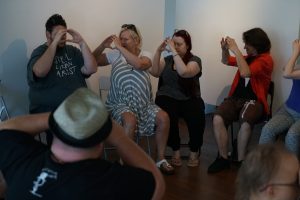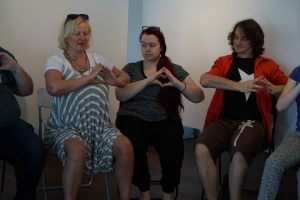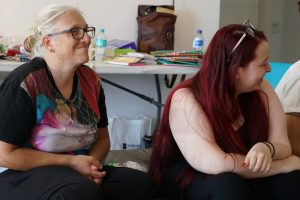

Our sign name introductions at the very beginning of the residency acted as more than just a ‘getting to know you’ exercise. They allowed us to create a common language and to peek inside the hearts and minds of those around us, forming a bond or sense of trust among us.
We then looked at one another. In partners. Just looking. Silence. Looking. Really seeing.


From there, we created portraits of ourselves without looking, and gave them a title based on what we saw in the person we drew right there on the page. We then drew portraits of our partners, again without looking, and presented them to our partners. We gave titles to the portraits our partners created, and it was so powerful to feel how someone else sees you – or what they see inside you. I was paired up with Gaele and found that though we were uncomfortable at first, once the giggles subsided, I saw Gaele’s heart by simply looking at her face and all the beautiful details that make it up. It was no surprise to me that the kindness, imagination, and creativity I saw in her face were all uncovered through the remainder of the residency as I saw her contributions to the group.
Jenny then asked us to pair up again, and measure each other using a completely different vocabulary. I partnered up with Chelle, a fantastic visual artist and an Auslan user. My Auslan skills are minimal at best, as I only started learning last year and vaguely know how to fingerspell and sign some other select words. But what was really powerful to me was how willing Chelle was to work with me, communicate with me, and be open with me. We measured ourselves using snake lollies and straws and deflated balloons, creating a new vocabulary, and I found myself challenged in not only thinking (re: creative vocabulary) but in communication; how can our work be accessible? What do we need to do together to ensure that both of us are adequately supported in this process? I found myself fingerspelling as much as possible, and apologising for my poor Auslan skills. Chelle told me that she was thankful that I was trying, and I came away from that exercise thinking that perhaps that’s the first key component to accessibility in performance:
trying
completely and honestly to do something that is so necessary, but being humble enough to accept when your attempts may not be up to scratch and learning to adapt quickly. This became clearer to me in the next exercise, where we used our new measurements to create a short performance. Chelle and I bonded over our hair – mine is quite long, and hers was the same until she cut it some time ago. We then created a short piece about Rapunzel, and Chelle signed the entire story. It was the first time I had not spoken in a performance piece in a very long time, but oh man, it was challenging and thrilling to place my complete trust in Chelle, even though I had not known her long let alone been able to communicate as quickly or as openly as I would have with a hearing, English user. I am so thankful for this experience and for Chelle’s kindness and understanding through this process – and I’m determined to become fluent in Auslan as soon as possible!
We then moved into groups. I worked with Belinda, Sarah, Phoebe and Kate to create a performance using small fragments of Sarah Kane’s 4:48 Psychosis text. It was interesting to see us come together from different pairings and find the ways in which our previous performances share similarities or strengths in form or style. We ended up creating a movement piece, capitalising on Sarah’s incredible skill as a physical performer whilst still respecting each other’s needs. For example, Kate’s powerchair does not easily swing around at the same pace we were moving around one another, so we made sure to position her for greater ease. I also expressed to the group that while moving and being intertwined was fine, I could not bear someone else’s weight in addition to my own. We knew that a visual cue for our end position would not be accessible for Sarah, so she become responsible for providing us with the cue instead.
These were not limits to the performance, but I feel that the group took them on as added circumstances within which the text could be explored, which was a truly fascinating concept. In the piece, we were constantly entangled, starting as a circle facing outwards and gradually moving around ourselves and one another whilst speaking some of the text (“I am a complete failure”, “This is becoming my normality”), always touching, and finally reaching a final state of us all facing in one direction and saying a line in unison. Performing this was a really powerful experience; my access requirements were respected and yet the piece we created was just as compelling as anything else that could have been made. I was not forced to comply with abled standards or to attempt to modify my own being to fit a particular mould. We created the piece, together, and I have never felt more connected to a group of near-strangers in my life.
Throughout the day, various elements of accessibility were also explored, such as the inclusion of audio description – literal audio description and abstract audio description, how do they differ in both application and in meaning? – but I feel that the lesson of the day was geared towards language, understanding, trust, vulnerability, and the willingness to push well within your limits whilst respecting the limits of those around you.
Day 1 was compelling, to say the least, and though I was exhausted and sore as I made it back to my hotel room, my mind was racing and my heart was going wild. I knew the best was yet to come and I was so unbelievably excited to keep going.
Sorry, the comment form is closed at this time.